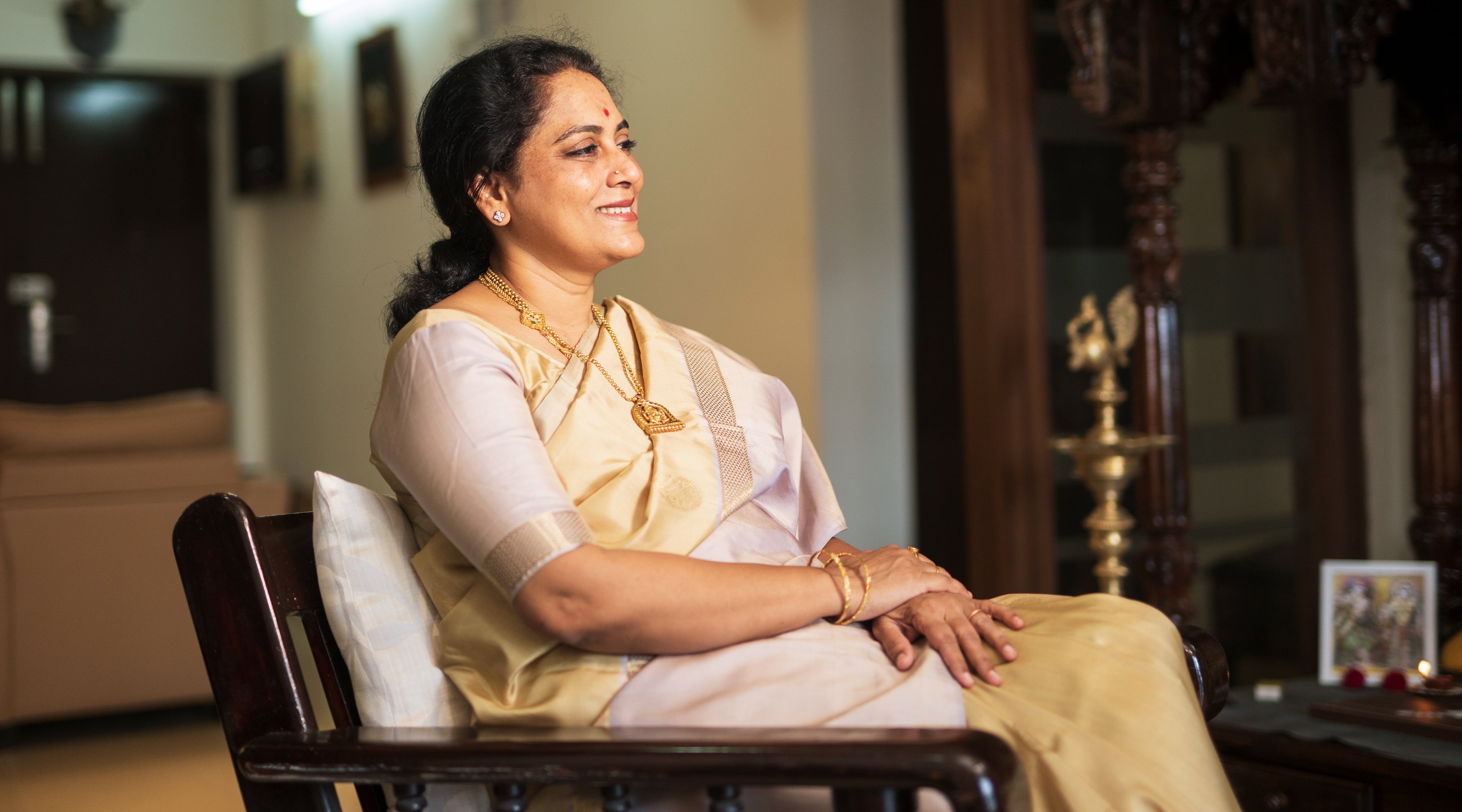Article: KANAKAVALLI VIGNETTES : Sudha Srinivas - Timeless Traditions
KANAKAVALLI VIGNETTES : Sudha Srinivas - Timeless Traditions

Sudha Srinivas, Kanakavalli’s July Vignette, is a homemaker whose quintessential South Indian childhood with her grandparents instilled in her a deep love for culture and tradition. In conversation with Aneesha Bangera for The Kanakavalli Blog, Sudha reminisces about growing up learning about the festivals that still bring her joy, and about the cities she spent time in. Sudha finds comfort in the rituals of prayer and delights in the little things—cooking seasonally, decorating her prayer room, and filling her home with objects she has collected over the years. She loves to visit temples, learning about their histories and mythologies, while soaking in the peace of the spaces. For Sudha, the kanjivaram is an extension of her personality, and beauty lies in being a good person.
Browsing through the Kanakavalli repertoire Sudha curates a selection of elegant saris that speak to her sense of beauty and tradition.
Excerpts of the conversation below…
Timeless Traditions
Tell us a little about your childhood and the ways in which your grandparents influenced you.
I spent much of my childhood with my grandparents along with my sisters and brothers. We lived in Bangalore and studied at Sophia’s school, and I remember travelling to Chennai and Madurai often. Some of my favourite memories are of our temple visits during the festive season of Dussehra. I was always very involved in celebrating Golu, as it is known in Tamil, and Bomamla Koluvu in Telugu—the display of dolls and figurines at home during the festival. I would spend a great deal of time and attention trying to create the perfect Golu, with the figures that we bought in Mylapore over the years.

Above (clockwise from left): Sudha as a young woman, photographed before her wedding; A portrait of Sudha on her wedding day; Sudha as a young mother, soon after giving birth to her daughter.
The highlight of our year used to be Diwali, when, to our absolute thrill, our grandfather would buy plenty of fireworks. My grandmother would make the most delicious sweets, arranged beautifully in trays for our relatives. We would all dress up and visit our family and friends to give them sweets, and they would give us more homemade sweets in return. Things are so different now with store-bought sweets exchanged during festivals, but that culture was very special to me.
I also remember our summer holidays—every year all our cousins from Hyderabad would come and spend their vacation with us in Bangalore. Those months were filled with fun and activity, and we would savour the days before we had to go back to school.

Above (top to bottom): Sudha as a child with her parents, aunts and uncles, and cousins; An old photograph of Sudha as a child with her siblings and grandparents who raised her.
My grandparents displayed strong traditional and cultural values in their day-to-day activities, something that I think I imbibed early on. My grandfather would hand pick authentic silk saris for my grandmother, and I always admired her collection of beautiful silks. She inspired me to wear the finest kanjivaram silk saris.
What are the things you carry with you from the cities you have lived and spent time in - Bangalore, Chennai, Madurai, Hyderabad?
I spent most of my school years in Bangalore, but we would often visit Chennai where my aunts and uncles lived. I have very fond memories of the city—eating ice-creams at Dasaprakash and having lovely picnics at the snake park near Gandhi Mandapam.
We would often visit Madurai, where my grandfather’s business was located. One of the best memories of my childhood was visiting the Madurai Meenakshi Amman temple, and even now it continues to be one of my favourite places to go.
After school, we moved to Hyderabad, where I got married and settled down. Since then, Hyderabad has become home.

Above (clockwise from top left): An old photograph of Sudha and her husband; With her daughter Aparna; Sudha and her husband sharing a moment of happiness.

I think I have drawn on the cultural and traditional values of every city that I have lived in. Every city had something unique to offer, and I adored the atmosphere of each. I think all of these cities have rich histories, reflected in the beautiful old architecture, while their culture is displayed in their intricate temples, which I also loved. As I grew up and continued to visit these cities, I also began to collect souvenirs to remind me of their rich heritage—Tanjore paintings, antique furniture, lamps, Golu figures, silk clothing and more. In this way, I carry each city with me wherever I am.
What are the traditions that you imbibed as you grew up, and the ones you hope to pass on to your children?

I inherited so many traditions from my family; ones that have helped guide me and define my life. I hope to pass all these on to my own children.
The art of decorating our pooja room with its offerings to the deity is a very important tradition to me. I also learnt the prayers and chants of our family from my grandparents. Some traditions are practical, everyday skills, such as knowing how to cook simple but nutritious meals that change with the seasons. I have also always been interested in the traditional ways of wearing dhotis and saris. The rituals and ceremonies associated with festivals are another aspect of tradition that I enjoy. Even now, I make all the traditional sweets and savouries, including different types of laddoos and murukkus, that I used to watch my grandmother lovingly make during Diwali.

Above: Sudha in her pooja room, her favourite space in the house where she celebrates the traditions she inherited.
I’m still in the process of handing down these traditions to my children, like heirlooms, and I hope they bring as much joy to them as they did to me.
How would you describe the way in which you have decorated your home? Tell us about your favourite spaces in the house.
My home is filled with objects I have collected over the years, from brass vessels and lamps to wooden carvings and Tanjore paintings. A lot of these are from my in laws while others are things I have inherited from my grandparents or collected on my travels. I have a beautiful print of Raja Ravi Varma’s Ram Pattabisheka which is one of my most prized possessions and takes pride of place in my pooja room. The Tanjore paintings are very ancient, some of them over a hundred years old. I’m not much of a reader, but I love my Tanjores and they feel like a part of my heritage.

Above (left to right): Celebrating Varalakshmi Vratham with fresh flowers and rituals; Sudha's collection of ancient Tanjore paintings.
I love to add garlands of fresh flowers, draw rangolis, and light diyas—all to add a sensory dimension to my home. My favourite space in the house is my pooja room—being there fills me with positivity and a sense of calm. I like to have chants playing in the background, and I believe this adds to the experience of my home.
What draws you to South Indian temples? Tell us a little about your travels to visit some of these.
My husband and I have visited temples across South India—in Chennai, Madurai, Trichy, Thiruvannamalai and Tirupati. I have always been drawn to these powerful spaces; the intelligence with which they have been designed and constructed, and the fascinating stories of consecration associated with each deity. Most importantly, I love the ambience within the structures and the richness of the culture that surrounds them.

Above (clockwise from top): A photograph from Sudha's recent trip to Kashi; With her husband at the Kanchi Kamakshi Temple in Kanchipuram; Sudha with her son pictured at home during a Shastipoorti ceremony.
I just got back from a visit to Kashi, one of my first trips to the North. Some of my favourite temples that I know I will keep returning to are the Srirangam Temple at Trichy and the many vast and beautiful temples of Kumbakonam.
How do you define beauty and tradition?
For me, beauty lies in being a good person.
Tradition consists of a heritage, beliefs and behaviours passed down from our ancestors.
What role does the sari, and the kanjivaram in particular, play in your life?
I grew up watching my grandmother wear the most beautiful authentic kanjivaram saris, in very traditional colours that have always been my favourites. Since then, I have loved the kanjivaram craft. The kanjivaram sari feels like an extension of me, and I believe that it has played an important role in moulding my personality. Wearing a sari makes me feel strong, positive, and confident. I take pride in my collection of beautiful and traditional kanjivaram silk saris, most from Kanakavalli!
I first visited Kanakavalli when I was in Coimbatore and I was so excited when the store opened in Hyderabad, very close to my home. I never miss a chance to go and browse the unique collections and I’m still waiting for the opportunity to wear some of the gorgeous saris I have bought from there.
What’s the story behind the Kanakavalli sari you chose to wear for the Vignettes shoot?
I chose this Kanakavalli sari from the Valli Muhurtham collection. I think the colour suits me and is perfect for the outdoors. I love the intricate work on the borders and pallu.

Sudha is wearing a classic magenta kanjivaram shot with dark mulberry purple and embellished with floral motifs in gold zari. Twill patterns adorn the borders while the pallu features peacock, horse and temple motifs in rich zari.
- Sudha Srinivas, in conversation with Aneesha Bangera, photography by Raghuram Vedant.
View Sudha's accompanying guest curation here.


